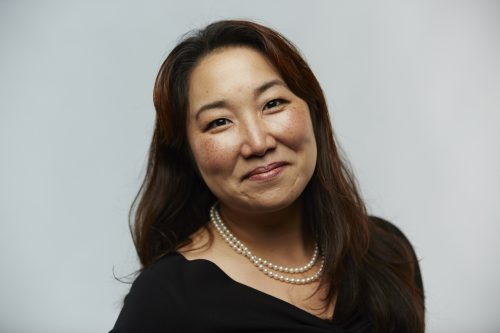
Image via Shutterstock
By Aimee Hansen
When it comes to Asian American women in business leadership, the steady storyline is often the professional, less likely the manager, and rarely the executive.
Asian Americans make up 6% of the US population, 12% of U.S. professionals, and yet only 5% of executives, leaving them “stuck in the middle”.
On Wall Street and in Silicon Valley, Asians comprise even higher percentages of professionals, but a much smaller percentage of senior executives. They make up 26.9% of professionals at Goldman Sachs but only 10.7% of senior executives, 23.1% of professionals at Citigroup Inc. but only 12.7% of executives, and 20.6% at JP Morgan but only 6.8% of executives.
Buck Gee, a retired Cisco Systems Inc. vice president and co-author of a new report from the nonprofit Ascend Leadership, said in Bloomberg: “We are the most successful minority.” But when the lens turns to C-suites and upper management, “we’re the least successful minority.”
It’s not an education problem or a hiring problem, or necessarily even a pipeline problem. It is, however, cultural – largely, a corporate cultural issue.
The corporate-defined stereotypes of leadership (masculine, aggressive) and the intersection of gender and racial stereotypes through which Asian American women are perceived play at least as big of a role as the instilled cultural norms that may keep Asians from advocating for themselves as leaders, while trusting in hard work being enough to bring results.
Companies are called to practice inclusivity: leadership development and demonstration that bridges (not falls through) the cultural gaps to get diverse talent into leadership roles.
Stereotypes and “Model Minority”
Due to high education, professional employment and income levels, strong entrepreneurism, and the “model minority” reputation, Asian Americans are often overlooked when it comes to encouraging diversity.
But Asian American women face both “positive” and “negative” stereotypes – that may lead to envy, resentment, dislike, or perceived lack of leadership qualification – and can hinder organizational advancement. They face the intersectional discrimination of “racialized-sexism” and “sexualized-racism.” Even the seemingly positive reputation of “model minority” is a skewed and distorted box that inhibits advancement when it comes to leadership. And, studies have shown “that Asian Americans, like other minority groups, are aware of and may even internalize the stereotypes attributed to them.”
According to a qualitative study published in the Global Journal of Human-Social Science that tracked 16 Asian female middle managers, Asian women reported that they “sometimes benefited from the positive associations of their Asian ethnicity with qualities such as intelligence and diligence, and sometimes they face the demerits of being Asians, that reinforce a view of them being passive and lacking in leadership skills.”
According to the research, the experiences of these women were “complex and conflicting.” Some participants reported that they were able to seize opportunities for self-actualization, personal empowerment, and career growth “by leveraging their Asian culture,” but others talked about a subtle cultural disconnect that created barriers to networking, as well as to conforming with the norms of American corporate culture.
Meanwhile, when it comes to executive ambition, Asian women are “more likely than white women to say that their goal is to reach the top of their profession.”
Missing at Executive and Middle-Management
“The Illusion of Asian Success” report focusing on the San Francisco Bay area tech companies, by the Ascend Foundation, found that despite being the biggest professional racial cohort across 2007–2015, Asians were the least likely to be promoted to manager or executive level.
“Asians are still the least upwardly mobile demographic to reach leadership positions in (San Francisco) Bay Area technology companies,” state the authors. “The widely-held notion of Asian executive success is largely an illusion.”
The report found that while they are “outnumbered by Asian men and women in the entry-level professional workforce, white men and women were twice as likely as Asians to become executives and held almost 3x the number of executive jobs.”
Ascend previously created the Executive Parity Index™ (EPI) – which “scores a company’s diversity in its executive workforce relative to its entry-level workforce.” The report found that between 2007 and 2015, white women went from 12% below parity to 17% above in 2015, but all racial and ethnic minorities remained below parity.
Asian women were especially unlikely to become Executives – going from 76% below (.24 EPI) executive parity in 2007 to 66% below (.34 EPI) in 2015. Meanwhile, Asian men went from 44% below parity to 38% below parity.
Ascend also introduced a new Management Parity Index™ (MPI) to look at mid-level management representation. Asian women had the lowest MPI of .54 in 2007 (45% below parity) and .69 (31% below parity) in 2015.
“Asians were the only minority group underrepresented in middle management,” the authors were surprised to find. “We conclude that Asians were not only the least likely to be executives in 2015, but also the least likely to become Executives in the near future.”
While the executive gender gap for Asian women is only 85% with Asian men, the racial gap is 246% with white women. As white women were promoted, race became the increasingly dominant limiting factor – going from twice as big as sex in 2007 to three times as big in 2015.
The report co-author Denise Peck, a former vice president at Cisco, stated “Minority women continue to bump against a double-paned glass ceiling. The data show that a general focus on developing women leaders has not addressed the distinct challenges for Asian, Black, or Hispanic women. This has been an unspoken truth in the minority community, and we hope that our report opens a long overdue dialogue.”
Companies Need to Build a Cultural Bridge
In the LA Times, writers Ramakrishnan and Lee note how a few highly visible tech leaders can create a false perception of Asian prominence among leadership: “while Asian Americans can get through Silicon Valley’s doors, they are unable to move up the ladders.”
The article asserts that Asian Americans are often perceived as having more hard skills (competence) and fewer soft skills (communication, collaboration), but that there is a gap in soft skill development and demonstration opportunities for Asian professionals.
In the 2016 National Asian American Survey, 68% of white employees indicated planning or chairing a meeting at work, while only 51% of Asian American employees had done so, despite an equal percentage (40%) indicating they served in a supervisor capacity.
Again, the gap grew among women, as Asian American women were “25 percentage points less likely to chair a meeting when compared with white women.” The LA Times writers state, “One obvious, simple and costless solution is for employers to make sure that everyone who’s qualified gets an opportunity to lead a business meeting.”
During Bloomberg’s “Walk the Talk” feature on why so many Asian Americans are absent from the C-Suite, Laura Colby said “many Asian executives who I talk to will themselves say that they credit a bit of their upbringing for them not being as aggressive perhaps as might be considered necessary to show that you want to advance in Corporate America.”
Colby emphasized, however, that companies have to be more inclusive to bridge exactly these cultural nuances: “There are some programs out there, but several of the people I spoke with said you really have to make a point of engaging all the groups in a corporation, not focus on a specific group, or blame people for their own lack of being able to climb the ladder when really it might be the ladder itself that is tilted and preventing them from getting where they want to get.”
Sometimes, it’s the ladder that is broken, or too narrow, or too weak, or too rigid, to allow change to climb as high as it needs to.









